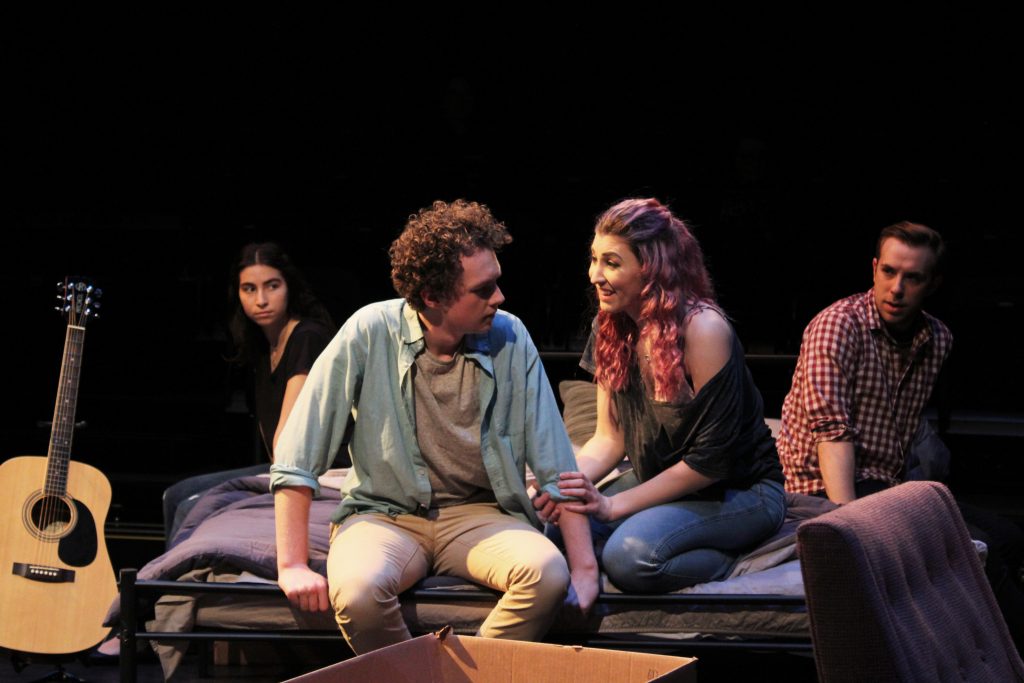This weekend, Binghamton University’s theatre department tackled the complexities of relationships with a unique, modern twist.
From Feb. 27 to March 1, the theatre department featured “Fish Eye,” a play written by Lucas Kavner and directed by Samantha Goss, a senior double-majoring in theatre and English. The production centers around two lovers, Max and Anna, who go through heartbreak and separate because of their respective career paths.
The two lovers meet in New York and eventually fall in love. The couple moves in together and after some time, Anna finds herself drawn to her passion for film as a career. As a result, she applies to the University of Southern California and winds up moving to the West Coast, leaving Max in New York. Their resulting long-distance relationship weakens their bond, and they both wind up cheating with other people, before Anna eventually tells Max she does not need him anymore and that they were only a block of time in each other’s lives.
The play tells the story of Max and Anna’s relationship in an unorthodox manner — the scenes of the story are out of order and are chronologically scattered, which Goss said she was her intent in choosing this play.
“When I was looking for a show that I wanted to direct for my thesis, I wanted to do something a little different and I found this play,” she said. “There’s not a lot of print things about it, I could only find one actual article and it was from the original production of it. I couldn’t find anything else, but it was really cool because the play was out of order and there was these snapshots of life, which is kind of how I thought about it — that someone had all these photographs they dropped and picked up randomly.”
To prepare for the unusual scene structure, the cast and crew worked on getting a grasp on the chronological order of the production before practicing the full play as written. Amelia Pena, the actor who plays Anna and a junior double-majoring in theatre and business administration, said preparing for “Fish Eye” posed unique challenges.
“It was really difficult, we did different rehearsals where we would do the whole thing in chronological order at the beginning of the rehearsal process,” she said. “That was to get the flow in our brains, but it was hard going from one moment to the next moment that are either way in the past or way in the future. Knowing the chronological script was really helpful.”
In addition to Max and Anna, the characters Jay and Avery were a part of the production and played unusual roles throughout the play.
“When I started with the script, [the characters] weren’t all on a set throughout the show,” Goss said. “That wasn’t what the playwright wrote, the directions were completely different from that. I wanted to do something different and cool — we came up with the idea of having Max and Avery who don’t know each other, and they never have a scene together or anything like that. They are manipulating the situation, trying to remind these two that they can’t get back together because of all these other things that have happened in the past, and so they’re trying to remind them the whole show why they shouldn’t get back together. [Jay and Avery] can go their own separate ways, and I thought it was really cool, playing around with having them on there. They weren’t a part of each scene, but how they could manipulate it and make scenes start, it was a lot of fun.”
With Jay and Avery constantly stepping in and out of scenes, Goss created a hectic and fast-paced atmosphere that captured the struggles of relationships. She said the play’s portrayal of love and relationships can connect with college students who often deal with difficult career choices.
“I think it can relate to everybody that deals with a lot of long-distance relationships, relationships from the past, friendships and that boundary between friendship and relationship,” Goss said. “There’s a lot of common themes that I think a lot of people can relate to, especially [those in] college, as all the actors are in their early 20s.”



